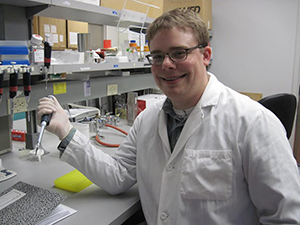by Stephanie Buckner in Cleveland Advocate
published March 14, 2014
Juvenile Batten Disease is an extremely rare, fatal and inherited disorder that affects the nervous system and begins in childhood.
For Chuck Meyer, who was most recently a congressional candidate for District 36, the rare disease is something that has become a big part of his everyday life.
Meyer’s 18-year-old daughter, Emily, was initially diagnosed as an explosive inflexible child, which Meyer describes is best understood by imagining a child that never outgrew tantrums that typically die down at an early age. Other effects of the disease became apparent as time goes by.
“Early on, we noticed her inability to differentiate between two objects that she would be looking at — like a plane in the sky — or we would be looking at a fish in the pond and she wouldn’t be able to see the fish at all, so we thought that was really strange,” said Meyer.
The Meyer family began taking Emily to get prepped for eyeglasses; however, optometrists were never able to get an accurate reading for her to do so and informed the Meyers’ that Emily’s optic nerve seemed to have never fully developed. With her condition worsening and with no explanation as to what exactly was happening to little Emily, the family began the pursuit of a diagnosis.
Eventually, a doctor noticed something concerning on Emily’s retina. The discovery led to a series of tests in an effort to rule out a variety of diseases.
“The doctor told us that her optic nerve was deteriorating and that it could be one of a number of things,” said Meyer. “He mentioned Juvenile Batten Disease but he told us not to go and look it up because it would probably scare us and it was highly unlikely that that’s what it was since it is so rare.”
Meyer admits that even though they had been advised not to do so, he and his wife did so regardless. They discovered many facts about the disease, which is essentially the gradual deterioration of the nervous system. One of the first things to be affected is vision, explaining Emily’s sight troubles.
“Many people see personality changes in their children and we never really saw that with Emily,” said Meyer. “Looking back there were some behavioral problems but we just never really suspected that that was what it was. When we did get the diagnosis, I literally fell out of my chair.”
He continues by saying that he “never in a million years thought that Emily would have this disease,” which he describes as incredibly complex.
Meyer credits the diagnosis with launching his potential political career, saying that in 2010, he believed that if he ran against Sheila Jackson Lee, he could use the press to garner some attention for rare childhood diseases. In 2014, he ran for Congressional District 36, but was defeated in the primary. Though he lost the race, his pursuit of awareness has not subsided.
He also advocates research for the disease and other rare childhood diseases. Baylor College of Medicine is one of the few research facilities that is currently striving to find a cure for the rare disease. The Beyond Batten Foundation is the one of which the Meyer family is very supportive, as it raises funding specifically for the research of Juvenile Batten Disease. The foundation has also worked to develop tests that parents can now use to determine the likelihood of children being born with diseases before conception.
“This is my passion; to try to get the word out to anyone who will listen about childhood diseases and about why we need more awareness throughout society,” said Meyer.
Currently, Emily processes things as a 6-year-old would, despite being a young adult. While she does utilize a wheelchair, she is not completely dependent upon it yet, though in time, she will be required to use it full time. She can no longer speak in complete sentences, though she is at a point where she still understands how to communicate her basic needs.
Emily, who once dreamed of being an Irish dancer and at one point, according to her father, was the only blind Irish dancer in the United States competitively, still uses her legs to mimic the movements of dances of which she is familiar. This May, Emily will be rolled across the stage at College Park High School, where she will receive her diploma.
“It is only through prayer that my wife and I have been able to get through this,” said Meyer. “Speaking about this is so much harder for me than any campaign speech because it is so personal. We have hopes that maybe she will live into her 30’s instead of her 20’s since her affliction is slower progressing than other forms.”
For more information about Juvenile Batten Disease, visit www.beyondbatten.org.
http://www.yourhoustonnews.com/cleveland/living/aspiring-politician-aims-to-spread-word-on-rare-childhood-diseases/article_2f7974ad-ab09-5cd6-87af-cbd01f52c8f5.html

